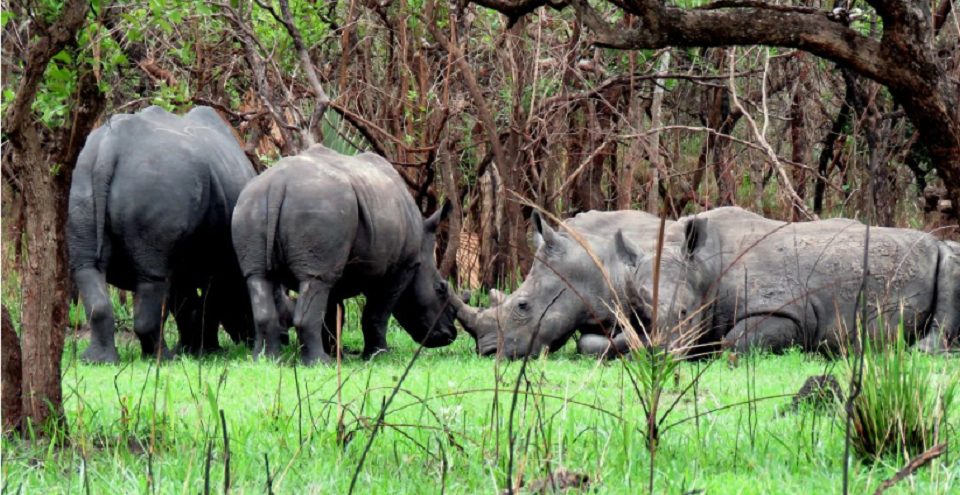
Exploring Lake Mburo
September 2, 2025
Top reasons to Mgahinga Gorilla National Park
September 2, 2025Ziwa-rhino-sanctuary, If you’re passionate about wildlife conservation or looking for an extraordinary wildlife experience in East Africa, Ziwa Rhino Sanctuary in Uganda is a must-visit destination. Nestled in the heart of Uganda’s beautiful savannah, Ziwa offers a rare chance to see rhinos up close — a sight increasingly scarce across Africa. This sanctuary is not only a beacon of hope for rhino conservation but also a fantastic place for eco-tourism, education, and adventure.
What is Ziwa Rhino Sanctuary?
Ziwa Rhino Sanctuary is Uganda’s first and only rhino sanctuary. Established in 2005, it covers approximately 70 square kilometers (about 17,000 acres) of protected wilderness in the Nakasongola District, roughly 3-4 hours north of Kampala, Uganda’s capital city.
The sanctuary was created to reintroduce the southern white rhino to Uganda, where rhinos had become extinct due to poaching decades earlier. It serves as a safe haven where rhinos are nurtured, protected, and bred, with the ultimate goal of returning them to Uganda’s national parks like Murchison Falls National Park.
The History and Conservation Efforts | Ziwa-rhino-sanctuary
Rhinos once roamed freely across Uganda, but relentless poaching and habitat loss wiped out the population by the late 20th century. The extinction of rhinos in Uganda was a big blow to biodiversity and the natural heritage of the region.
In response, the Uganda Wildlife Authority (UWA) partnered with private conservationists to establish Ziwa Rhino Sanctuary. The first rhinos, four southern white rhinos, were imported from Kenya in 2005. Since then, the population has grown steadily, with careful monitoring and anti-poaching patrols in place to ensure their safety.
Ziwa Rhino Sanctuary is also a breeding center, with successful births helping to increase the population. The sanctuary plays a vital role in training and educating local communities and wildlife rangers about rhino conservation and the importance of protecting endangered species.
What to Expect When Visiting Ziwa Rhino Sanctuary
Rhino Tracking and Viewing | Ziwa Rhino Sanctuary
Rhino trekking in Ziwa rhino sanctuary
One of the most remarkable wildlife experiences in Uganda—and indeed, East Africa—is the guided rhino tracking at Ziwa Rhino Sanctuary. This unique opportunity allows visitors to observe southern white rhinos (Ceratotherium simum simum) up close, on foot, in a protected natural environment.
The Southern White Rhino: The Stars of Ziwa | Ziwa-rhino-sanctuary
Ziwa Rhino Sanctuary is home exclusively to the southern white rhino, one of the two subspecies of white rhinos. These are distinct from the black rhino species found elsewhere in Africa. The southern white rhino is the largest of the rhino species and is known for its wide, square lips adapted for grazing grass. They are generally more social than black rhinos and can be seen in small groups.
Key features of southern white rhinos include:
-
Size and Weight: Adults can weigh between 1,800 to 2,700 kg (4,000 to 6,000 lbs), with males typically larger than females.
-
Color: Despite the name, their skin is actually grey; “white” is believed to be a mistranslation of the Afrikaans word “wijd,” meaning “wide,” referencing their broad lips.
-
Behavior: Southern white rhinos are predominantly grazers, feeding mostly on grasses. They tend to be more tolerant of other rhinos nearby and may form small herds, especially females with calves.
-
Social Structure: Dominant bulls establish territories that they defend from rivals, while females and their offspring often move within overlapping home ranges.
At Ziwa, the rhinos are semi-wild—they roam freely in a large, natural habitat but are closely monitored and protected by sanctuary staff.
The Rhino Population at Ziwa | Ziwa-rhino-sanctuary
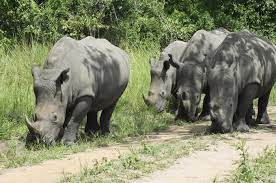
rhinos grazing at Ziwa rhino sanctuary
Currently, Ziwa Rhino Sanctuary houses approximately 20 to 25 southern white rhinos, a number that is steadily increasing thanks to dedicated conservation efforts. The rhinos were originally brought to Ziwa as part of Uganda’s efforts to reintroduce rhinos into the wild after local extinction due to poaching in the 1980s and 1990s.
The sanctuary serves as a critical breeding ground, ensuring the species’ survival in Uganda. Some rhinos here are mature adults, some are sub-adults, and the sanctuary proudly hosts several calves born in recent years, signaling a healthy and thriving population.
What to Expect During the Tracking Experience | Ziwa-rhino-sanctuary
Guided by trained and armed rangers, visitors embark on a walking safari through the sanctuary’s savannah and woodland habitats. The guides are not only experts in safety and animal behavior but are also deeply knowledgeable about rhino conservation, the history of the sanctuary, and the individual rhinos living there. Before the trek begins, you’ll receive a short briefing covering safety protocols and what to expect in the bush.
Tracking typically begins early in the morning or later in the afternoon—when temperatures are cooler and the rhinos are more active. Using fresh signs like footprints, dung, and browsing patterns, rangers lead you toward the rhinos’ current location.
Once the rhinos are located, visitors quietly approach them, often getting within 10 to 15 meters. Watching a massive adult rhino graze calmly, or observing a mother tending to her calf, is a powerful and humbling experience. Unlike traditional game drives, this walking encounter is intimate, immersive, and devoid of vehicle noise—allowing for deeper connection and observation.
Conservation and Visitor Impact | Ziwa-rhino-sanctuary
Ziwa Rhino Sanctuary is Uganda’s only location where wild rhinos can currently be observed, making it a vital conservation site. The sanctuary’s work includes anti-poaching patrols, veterinary care, habitat management, and community outreach.
Visitors directly support these efforts, as fees and donations fund the sanctuary’s operations. Rhino tracking is therefore not just a safari activity but an active part of the ongoing protection and reintroduction project for Uganda’s rhinos.
Practical Information for Rhino Tracking | Ziwa Rhino Sanctuary
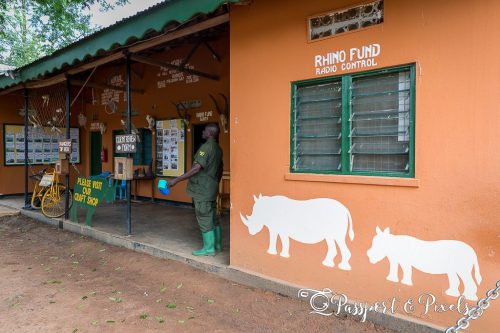
Information centre
To ensure that your rhino tracking experience is both enjoyable and safe, it’s important to be well-prepared and informed. Here are some essential practical details and tips to help you get the most out of your visit:
Duration
-
Rhino tracking generally lasts between 1.5 to 2.5 hours, depending on where the rhinos are located that day.
-
The time includes walking to the rhinos, observing them in the wild, and returning to the starting point.
-
Occasionally, if rhinos have moved farther afield, the trek may be longer, but the guides always prioritize visitor safety and comfort.
Best Time to Track | Ziwa-rhino-sanctuary
-
Early morning (7:00 AM to 10:00 AM): Cooler temperatures and increased rhino activity make mornings ideal for tracking. Animals tend to graze and move around more during this time.
-
Late afternoon (3:00 PM to 5:00 PM): Late afternoons also see heightened rhino activity as temperatures drop before sunset.
-
Midday tracking is generally avoided due to heat and the rhinos’ tendency to rest in shade during this period.
Fitness Level and Terrain | Ziwa-rhino-sanctuary
-
The activity requires a moderate level of fitness since visitors will be walking approximately 2 to 4 kilometers over uneven and sometimes muddy terrain.
-
Paths can include grasslands, woodland trails, slight inclines, and areas near wetlands, so expect some natural obstacles like rocks, roots, and uneven ground.
-
The walking pace is generally slow and steady to avoid disturbing the rhinos and other wildlife, making it accessible for most people with reasonable mobility.
-
Visitors with mobility challenges should discuss options with the sanctuary in advance to ensure safety and accessibility.
What to Bring | Ziwa-rhino-sanctuary
Briefing of tourists
Proper gear enhances your comfort and safety during the tracking experience:
-
Sturdy walking shoes or boots: Closed-toe shoes with good grip are essential for uneven terrain and possible muddy patches.
-
Long pants: To protect against insect bites, scratches from vegetation, and sun exposure.
-
Hat and sunglasses: To shield from sun during open walks.
-
Insect repellent: Mosquitoes and other insects can be present, especially near wetland areas.
-
Water: Staying hydrated is important, so bring at least 1 liter of water. Bottled water is available at the sanctuary.
-
Binoculars: Useful for spotting rhinos or other wildlife from a distance without disturbing them.
-
Camera with a zoom lens: For capturing close-up photos while maintaining a safe distance.
-
Sunscreen: Apply before and during the trek to protect against sunburn.
-
Lightweight, breathable clothing: Comfortable for walking and suited to the tropical climate.
Safety Guidelines | Ziwa-rhino-sanctuary
Close encounter with the Rhino
Visitor safety is a top priority, and strict protocols are followed during every tracking session:
-
Visitors must stay with the assigned guides and rangers at all times. Wandering off alone is strictly prohibited.
-
Guides are armed and trained in rhino behavior and emergency protocols, ensuring safe encounters.
-
The group maintains a safe distance—usually around 10 to 15 meters—from the rhinos to avoid stressing the animals or provoking defensive behavior.
-
Silence and calm behavior are required to avoid startling the rhinos or other wildlife.
-
Flash photography is discouraged as it may disturb the animals.
-
If rhinos show signs of agitation (e.g., snorting, pawing ground, charging posture), the guides will immediately lead the group away.
-
Visitors with children under a certain age may need to check with the sanctuary for tracking eligibility.
-
The sanctuary reserves the right to cancel or adjust tracking based on weather, rhino movement, or safety considerations.
Other Wildlife and Nature | Ziwa Rhino Sanctuary
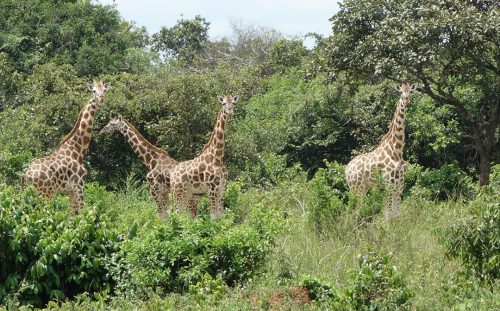
giraffe watching at Ziwa rhino sanctuary
Besides the white rhinos, several mammal species can be observed throughout the sanctuary. Most sightings occur during nature walks or rhino tracking experiences, often guided by trained rangers.
-
Hippopotamus – Common in the sanctuary’s swampy and wetland areas. These semi-aquatic mammals are usually spotted wallowing in water during the day or grazing at dusk.
-
Ugandan Kob – A graceful antelope and one of Uganda’s national symbols. These animals thrive in the open savannah and are often seen in herds.
-
Bushbuck – Solitary and shy, these medium-sized antelopes are usually found near thickets or forest edges, where they remain partially hidden.
-
Waterbuck – Identified by their shaggy brown coats and distinctive white ring on the rump. They are commonly seen near water bodies.
-
Warthogs – Easily recognizable by their tusks and habit of running with their tails held upright. They graze openly in grassland areas.
-
Vervet Monkeys – Social primates frequently seen near forested zones and lodge areas. Known for their curiosity and playful behavior.
-
Black-and-white Colobus Monkeys – Arboreal monkeys that prefer the sanctuary’s wooded patches. Their striking black-and-white coats and long tails make them easy to identify in the trees.
-
Ground Squirrels – Small, quick mammals that dart across open paths or grassy clearings.
-
Common Duiker – Small, secretive antelope usually seen alone or in pairs, often in woodland or near forest patches.
-
Reptiles – Including Nile monitor lizards, various chameleons, and several snake species like pythons and cobras, although reptile sightings are less frequent due to their secretive nature.
Birdlife at Ziwa: A Birdwatcher’s Paradise | Ziwa-rhino-sanctuary
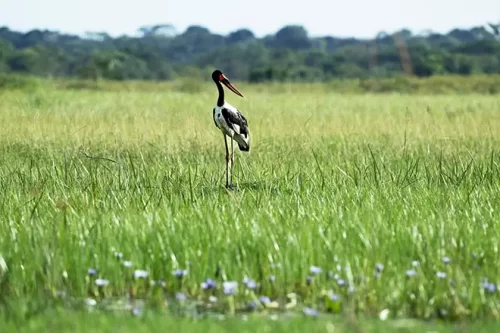
birds at Ziwa rhino sanctuary
Notable bird species include:
-
African Fish Eagle – Easily identified by its white head and piercing call, often seen perched near water.
-
Shoebill Stork – A rare and highly sought-after species found in the swampy sections of the sanctuary, particularly during early morning boat or walking excursions.
-
Grey Crowned Crane – Uganda’s national bird, known for its striking plumage and elaborate courtship dances.
-
Malachite Kingfisher – A brilliantly colored small bird often seen hovering near water, hunting for fish.
-
Pied Kingfisher – Recognizable by its black and white markings, frequently hovering before diving into water.
-
Giant Kingfisher – The largest of the kingfisher family, often spotted perched on branches overhanging water bodies.
-
Abyssinian Ground Hornbill – A large terrestrial bird that walks through the grasslands in search of insects and small reptiles.
-
Woodland Kingfisher – Known for its turquoise-blue feathers and distinctive call, commonly seen during the rainy season.
-
Hadada Ibis – A large, noisy bird with a loud “haa-haa-haa” call, often foraging in open areas.
-
African Grey Hornbill and Crowned Hornbill – Found in the wooded areas, these birds are known for their large, curved beaks and loud calls.
-
Cattle Egret – Often seen around larger mammals, feeding on insects stirred up by their movement.
-
Open-billed Stork, Black-headed Heron, African Jacana, Little Egret, Hammerkop, Yellow-billed Duck, and many others.
Birdwatching at Ziwa can be done on foot, making it a uniquely intimate experience. The swamp area near the sanctuary’s core zone is particularly rich in birdlife, with early morning being the best time for sightings.
Guided Nature Walks and Bird Watching | Ziwa Rhino Sanctuary
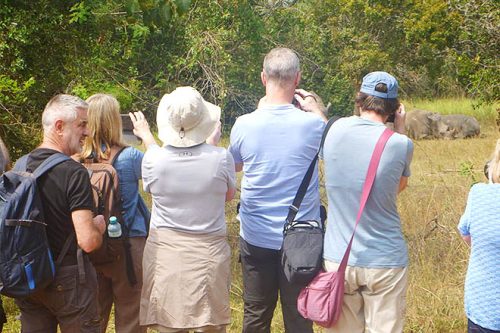
Group of tourists at Ziwa rhino sanctuary
While Ziwa Rhino Sanctuary is best known for its successful rhino reintroduction program, it also offers a rich and immersive natural experience that goes far beyond these majestic giants. For those with a passion for nature, ecology, and birdlife, guided nature walks and bird watching tours at Ziwa provide an unforgettable opportunity to connect with Uganda’s lesser-known biodiversity.
Explore More Than Just Rhinos | Ziwa-rhino-sanctuary
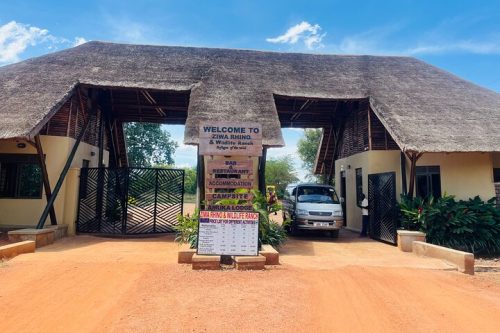
Main entrance of Ziwa rhino sanctuary
The sanctuary spans over 70 square kilometers of acacia woodland, savannah, and swampland—each habitat teeming with life. Accompanied by expert guides, nature walks at Ziwa take you through some of the most beautiful and ecologically diverse parts of the sanctuary. These walks are typically conducted early in the morning or late in the afternoon when wildlife is most active and the heat is more manageable.
Along the way, guides introduce visitors to the region’s native plant life, explaining the ecological roles and traditional uses of various species. From medicinal trees to flowering shrubs and grasses that support local herbivores, you’ll gain a deeper understanding of the sanctuary’s delicate ecosystem.
In addition to plant life, guests often spot other wildlife such as:
-
Uganda kobs
-
Oribis
-
Waterbucks
-
Bushbucks
-
Warthogs
-
Mongoose
-
Occasional sightings of leopards and other elusive predators
Every walk is a new adventure, offering insights into animal behavior, tracks, droppings, and other signs of life that often go unnoticed from a vehicle.
A Bird Watcher’s Paradise | Ziwa-rhino-sanctuary
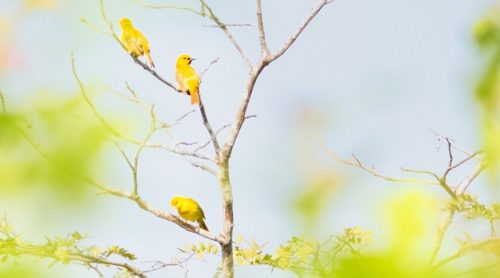
Bird watching at Ziwa rhino sanctuary
For birding enthusiasts, Ziwa is a true hidden gem. With over 300 recorded bird species, the sanctuary is one of Uganda’s prime birding destinations. Whether you’re an experienced birder or a curious beginner, the diversity and accessibility of birdlife at Ziwa make it an ideal location for spotting both common and rare species.
Highlights for bird watchers include:
-
Shoebill stork – One of the most sought-after birds in Africa, best spotted in the Lugogo Swamp area of the sanctuary.
-
Abyssinian ground hornbill
-
Grey crowned crane (Uganda’s national bird)
-
Goliath heron
-
African fish eagle
-
Blue-breasted kingfisher
-
Saddle-billed stork
-
Numerous species of sunbirds, weavers, and warblers
The sanctuary offers dedicated bird watching walks led by guides trained to identify species by sight and sound. Binoculars and birding checklists are available, and photographers will find plenty of opportunities for close-range shots in the sanctuary’s open and semi-open habitats.
Why Choose a Guided Experience?
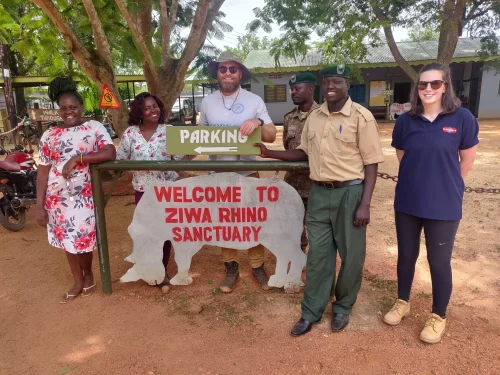
guide giving instructions
Guided walks and birding excursions at Ziwa are not just about seeing wildlife—they’re about learning. The sanctuary’s guides are well-trained, passionate, and deeply knowledgeable. They’ll help you spot camouflaged animals, identify calls, and explain the ecological relationships between species.
Because Ziwa is not overrun with tourists, these experiences tend to be quiet, personal, and unhurried—perfect for travelers looking for a deeper, more meaningful connection with nature
Cultural Experiences and Community Involvement | Ziwa Rhino Sanctuary
When most people think of Ziwa Rhino Sanctuary, their minds immediately go to the thrilling experience of tracking one of Uganda’s most endangered species—the southern white rhino. But beyond the exciting wildlife encounters lies a deeper, equally impactful aspect of the sanctuary: its strong ties to the local communities and commitment to sustainable development through community involvement.
Conservation Meets Community
Ziwa Rhino Sanctuary isn’t just about protecting rhinos; it’s about creating a conservation model that benefits both wildlife and people. The sanctuary actively collaborates with nearby villages, integrating community development into its conservation mission. These partnerships are not only essential for protecting endangered species but also for ensuring that local people see the value in conserving their natural heritage.
One of the key ways this is achieved is through community-based tourism. A portion of the revenue generated from visitor fees, guided tours, and on-site accommodation goes directly into funding local projects such as education, healthcare, and infrastructure improvements. This approach ensures that conservation doesn’t come at the cost of human development—instead, the two are deeply intertwined.
Authentic Cultural Experiences
Visitors to Ziwa Rhino Sanctuary often have the opportunity to go beyond the traditional wildlife experience by engaging in cultural exchanges with nearby communities. Depending on your itinerary and time of visit, you may be invited to:
-
Visit local homes and farms, where you can see firsthand how rural Ugandans live and work.
-
Watch traditional dance performances, often performed by local youth groups trained to share their cultural heritage with visitors.
-
Participate in craft-making workshops, where artisans teach guests how to weave baskets, make jewelry, or create other traditional crafts.
-
Taste local cuisine, sometimes cooked and shared in community-led dining experiences.
These cultural experiences are not staged—they are real, respectful engagements designed to foster mutual understanding and appreciation. For many travelers, these moments become the most memorable parts of their journey.
Empowering Local People
Ziwa’s collaboration with local communities goes far beyond tourism. The sanctuary employs many local residents as rangers, guides, hospitality staff, and in support roles. Through training and employment opportunities, locals gain valuable skills and stable incomes, reducing dependence on activities like poaching or unsustainable farming.
Additionally, Ziwa supports educational outreach programs in nearby schools, teaching children about wildlife conservation and environmental stewardship. By investing in the next generation, the sanctuary helps cultivate a culture of conservation from the ground up.
A Model for Sustainable Conservation
The model used at Ziwa Rhino Sanctuary is a powerful example of how conservation efforts can thrive when they include—and prioritize—local communities. When people are empowered to protect their environment and see tangible benefits from tourism, conservation becomes a shared mission.
Whether you come to Ziwa to track rhinos through the bush or to connect with Ugandan culture, your visit plays a part in this bigger picture. Every step you take supports a delicate balance—between nature and community, between protection and progress.
Practical Information for Visitors to Ziwa Rhino Sanctuary
Planning a visit to Ziwa Rhino Sanctuary? Here’s everything you need to know to make the most of your trip—from how to get there to the best time for wildlife viewing.
Location
Ziwa Rhino Sanctuary is located in Nakasongola District, in central Uganda. It lies approximately 160 kilometers (100 miles) north of Kampala, the capital city.
The sanctuary is conveniently situated along the Kampala–Gulu highway, making it a natural stop for travelers heading to Murchison Falls National Park.
Getting There
Ziwa is easily accessible by road, and most visitors reach the sanctuary via:
-
Private vehicles (self-drive)
-
Organized tours or safaris arranged by tour operators
-
Public transport to nearby towns like Nakitoma, followed by local transport (though this is less common for tourists)
The journey from Kampala takes 3 to 4 hours, depending on traffic and road conditions. The road is mostly paved and in good condition, though a short stretch near the sanctuary entrance may be gravel or dirt.
Opening Hours
The sanctuary is open daily from:
8:00 AM to 5:00 PM
-
The last rhino tracking session usually begins by 3:00 PM, so it’s recommended to arrive well before that to enjoy the full experience.
-
Early morning visits are ideal for bird watching and guided nature walks due to cooler temperatures and more active wildlife.
Entrance Fees
All visitors are required to pay an entrance fee, which contributes directly to rhino conservation and the sanctuary’s community projects. Prices may vary for:
-
Foreign tourists
-
East African citizens
-
Ugandan residents
-
Children vs. adults
Additional fees may apply for guided activities, such as:
-
Rhino tracking
-
Bird watching tours
-
Nature walks
-
Shoebill canoe excursions (if available)
Tip: It’s best to check with the sanctuary or your tour operator in advance for the latest fee structure.
Best Time to Visit
Ziwa Rhino Sanctuary is open year-round, but the best time for wildlife viewing and outdoor activities is during the dry seasons:
-
December to February
-
June to August
During these months:
-
Wildlife tends to gather around water sources, making them easier to spot.
-
Trails are drier and more accessible for walking.
-
There are fewer mosquitoes and less risk of heavy rains disrupting your plans.
However, the green (wet) season also has its charm—lush landscapes, migratory birds, and fewer tourists. If you’re a birder, the rainy months (especially March to May) can be rewarding, but be prepared for muddy conditions.
What to Bring
To ensure a comfortable and safe visit, pack the following essentials:
-
Comfortable walking shoes or boots
-
Lightweight, long-sleeved clothing (for sun and insect protection)
-
Sunscreen and a wide-brimmed hat
-
Insect repellent
-
Refillable water bottle
-
Binoculars (especially for bird watching)
-
Camera (with zoom lens if possible
Where To Stay | Ziwa-rhino-sanctuary
Whether you’re looking for an eco-lodge in the heart of the sanctuary, a cultural homestay, or a stopover on a longer safari route, there’s something for everyone. Here’s a guide to the best accommodation options near Ziwa Rhino Sanctuary.
1. Amuka Safari Lodge – Comfort in the Wild | Ziwa-rhino-sanctuary
Located inside the sanctuary, Amuka Safari Lodge offers a comfortable and tranquil stay surrounded by dense woodland. The lodge features spacious, unfenced chalets with private verandas, solar-powered amenities, and an inviting atmosphere that blends beautifully with the natural surroundings.
With an on-site restaurant, swimming pool, and Wi-Fi, this is an ideal spot for travelers looking to experience wildlife up close without giving up modern comforts.
2. Ziwa Guest House & Campsites – Budget-Friendly and Close to Nature | Ziwa-rhino-sanctuary
For a more rustic, budget-conscious option, Ziwa’s guesthouse and camping area offer a simple yet satisfying stay right within the sanctuary. Visitors can choose from basic rooms with shared facilities or pitch tents at designated camping spots.
It’s a great choice for backpackers, overlanders, and nature lovers who enjoy the basics and want to stay close to the action.
3. Nakasongola Homestays – Live Like a Local – Ziwa-rhino-sanctuary
For a cultural twist to your stay, local homestays in nearby villages offer a chance to experience life with the Bagungu people. These community-run accommodations allow visitors to stay with local families, enjoy traditional meals, and participate in day-to-day village life.
It’s a meaningful way to connect with the culture, support local livelihoods, and gain a deeper understanding of the region beyond the sanctuary.
4. Butiti Ranch House – A Private Countryside Retreat | Ziwa-rhino-sanctuary
Just outside the sanctuary in the nearby town of Nakitoma, Butiti Ranch House offers a peaceful and private retreat ideal for families or small groups. Set on a quiet ranch, the house features two bedrooms, a cozy living area, and expansive views of the countryside.
It’s perfect for travelers looking for seclusion, nature, and the comforts of home while staying close to the sanctuary.
5. Masindi Town Hotels – Ideal for Safari Stopovers | Ziwa-rhino-sanctuary
If you’re combining your Ziwa visit with a trip to Murchison Falls National Park or heading further north to Kidepo Valley, staying in Masindi town can be a smart choice. The town has a range of accommodation options, from historic hotels with colonial charm to simpler guesthouses with all the essentials.
Masindi offers easy access to both Ziwa and the broader safari circuit, making it a convenient base for travelers on the move.
Why Visit Ziwa Rhino Sanctuary?
1. Support Conservation | Ziwa-rhino-sanctuary
By visiting Ziwa Rhino Sanctuary, you are actively supporting one of Uganda’s most important wildlife conservation projects. The entrance fees and tour payments directly fund anti-poaching patrols, veterinary care, habitat management, and ongoing rhino breeding programs. These efforts are crucial in helping to restore Uganda’s rhino population, which was completely wiped out due to poaching in the late 20th century. Your visit enables conservationists to maintain a safe environment where rhinos can thrive, and helps build momentum for eventually reintroducing rhinos into larger national parks. Essentially, you become a vital part of a real-world conservation success story.
2. Unique Wildlife Experience | Ziwa-rhino-sanctuary
Ziwa Rhino Sanctuary offers a rare and authentic opportunity to track rhinos on foot—a wildlife encounter that’s extremely difficult to find anywhere else in Africa. Most wildlife safaris involve spotting animals from vehicles, but at Ziwa, you’ll walk through the bush alongside expert guides, tracking these massive and impressive animals in their natural habitat. This hands-on experience lets you see rhinos’ behaviors, social dynamics, and even newborn calves up close, creating memories that last a lifetime. The sanctuary’s manageable rhino population increases your chances of a close and safe sighting, making this an unforgettable wildlife adventure.
3. Educational Value | Ziwa-rhino-sanctuary
Visiting Ziwa Rhino Sanctuary is not just about sightseeing—it’s an immersive educational journey. The guides and rangers are passionate conservationists who share fascinating insights into rhino biology, behavior, and the challenges of protecting endangered species. You’ll learn about the devastating impact of poaching, the importance of habitat preservation, and the innovative techniques used to protect and breed rhinos in captivity. Moreover, the sanctuary is a hub for conservation research and training, so your visit contributes to raising awareness and inspiring future conservation efforts locally and globally.
4. Beautiful Natural Setting | Ziwa-rhino-sanctuary
Beyond the rhinos, Ziwa Rhino Sanctuary is set in a stunning landscape of East African savannah, wetlands, and woodland. This diverse ecosystem supports a wide range of flora and fauna, making every moment in the sanctuary a chance to enjoy nature’s beauty. Bird enthusiasts will delight in spotting colorful species like African fish eagles, hornbills, and kingfishers. The peaceful environment offers excellent photographic opportunities, whether capturing majestic rhinos, vibrant birdlife, or sweeping landscapes. It’s a refreshing escape into Uganda’s wild heart where you can reconnect with nature.
5. Community Impact – Ziwa-rhino-sanctuary
Ziwa Rhino Sanctuary works closely with surrounding local communities to ensure that conservation and human well-being go hand in hand. Tourism revenues help fund community development projects such as schools, health centers, and clean water initiatives. The sanctuary also creates employment opportunities for locals as guides, rangers, hospitality staff, and artisans selling crafts to visitors. By visiting Ziwa, you contribute to improving local livelihoods and fostering positive attitudes toward wildlife conservation. Supporting community engagement helps build sustainable conservation models that protect wildlife and empower people simultaneously.
Summary:
When you visit Ziwa Rhino Sanctuary, you’re not just going on a typical safari—you’re joining a powerful conservation movement. You’ll experience thrilling wildlife encounters, deepen your understanding of environmental challenges, bask in Uganda’s natural beauty, and help uplift local communities. It’s a holistic travel experience where every step you take makes a positive impact on wildlife and people alike.
Final Thoughts – Ziwa-rhino-sanctuary
Ziwa Rhino Sanctuary stands as a shining example of how dedication, collaboration, and sustainable tourism can bring a species back from extinction. For travelers seeking an authentic and meaningful wildlife experience in Uganda, a visit to Ziwa is not just a trip — it’s an opportunity to be part of a vital conservation story and witness the power of nature’s resilience.
If you find yourself in Uganda, don’t miss the chance to walk with rhinos, explore the savannah, and support a sanctuary that’s making a real difference for one of Africa’s most iconic animals.

